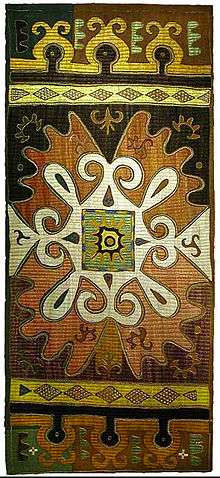Lily Yeats

Susan Mary "Lily" Yeats (/ˈjeɪts/; 25 August 1866 – 5 January 1949) was an embroiderer associated with the Celtic Revival. Born in County Sligo, Ireland, she was the daughter of John Butler Yeats and the sister of William Butler, Jack and Elizabeth Yeats. She became involved in the Arts and Crafts movement in London, working as assistant to May Morris. Returning to Dublin in 1900, she and her sister Elizabeth joined Evelyn Gleeson in the Dun Emer crafts studio, where she ran the needlework section. In 1908 she founded the embroidery department of Cuala Industries, with which she was involved until its dissolution in 1931. She is known for her embroidered pictures.
Career
The Yeats family settled in Bedford Park, London, in 1888, and the family often visited William Morris at Kelmscott House. Money was tight, and Lily was offered an opportunity to learn embroidery in the style propounded by Morris, which would become known as art needlework. She studied under Morris's daughter May, who ran the embroidery section of Morris & Co., and on 10 December 1888 was paid ten shillings for her first week's work for the firm.[1] By March 1889 Lily was training embroideresses for the firm.[2]
Lily continued to work under May Morris for six years, but their relationship was strained (she called her employer "the Gorgon" in her scrapbook)[1] In 1895, Lily caught typhoid fever while in France, and her health remained uncertain for the remainder of the decade.[3] After their mother's death in 1900[4] Lily and her sister Elizabeth returned to Ireland with their friend Evelyn Gleeson. In 1902 the three founded a craft studio near Dublin which they named Dun Emer (the Fort of Emer) after Emer, the wife of Irish legendary hero Cuchullain. Dun Emer became a focus of the burgeoning Irish Arts and Crafts Movement, focusing on embroidery, printing, and rug and tapestry-making. They recruited young local women to the enterprise, teaching them painting, drawing, cooking, sewing, and the Irish language in addition to the Guild's core crafts.[2] Lily Yeats ran the embroidery department, which created textiles for church decoration and domestic use.[5][6]
In 1904, the operation was reorganized into two parts, the Dun Emer Guild run by Gleeson and Dun Emer Industries under the direction of the Yeats sisters, and in 1908 the groups separated completely. Gleeson retained the Dun Emer name, and the Yeats sisters established Cuala Industries at nearby Churchtown, which ran a small press, the Cuala Press, and an embroidery workshop. William Butler Yeats's wife George (Bertha Georgina), helped Lily run the embroidery arm of the studio which produced clothing and linens.[4][5]
The Yeats sisters lived together through their adult lives, albeit contentiously. In 1923, Lily fell dangerously ill with what was believed to be tuberculosis while on holiday in London, and her brother lodged her in a London nursing home in July, where she remained until the following April.[7][8] On her recovery, she returned to Cuala, but the embroidery department was never a resounding success. Lily's health deteriorated again in 1931 (her ailment had finally been correctly diagnosed as a malformed thyroid in 1929[9]), and the decision was made to dissolve the embroidery branch of Cuala. At the time, Lily wrote
I never should have taken up the work after my illness. The eight years have been a very great strain, and each year a small loss, adding up.[10]
Lily Yeats continued to sell embroidered pictures in the following years.[10] She died in 1949.[11][12]
Notes
References
- "History of the Cuala Press". Boston College Libraries Newsletter. Fall 2008. Retrieved 2009-07-26.
- Susan Yeats at Trent University Archives
- Brown, Terence (2001). The Life of W. B. Yeats. Wiley-Blackwell. ISBN 0-631-22851-9.
- Faulkner, Peter (November 1995). "Dark Days at Hammersmith: Lily Yeats and the Morrises" (PDF). Journal of William Morris Studies. William Morris Society. 11.3 (Autumn 1995): 22–25. Retrieved 26 July 2009.
- Foster, R.F. (2005). W. B. Yeats: A Life Volume II: The Arch-Poet 1915-1939. Oxford University Press. ISBN 0-19-280609-2.
- Pyle, Hilary (1989). Jack B. Yeats: A Biography. Rowman & Littlefield. ISBN 0-389-20892-2. Retrieved 28 July 2009.
- Saddlemyer, Ann (2004). Becoming George: The Life of Mrs W. B. Yeats. Oxford University Press. ISBN 0-19-926921-1. Retrieved 26 July 2009.
- Sheehy, John (1980). The Rediscovery of Ireland's Past: The Celtic Revival 1830–1930. Thames and Hudson. ISBN 0-500-01221-0.
Further reading
- Hardwick, Joan. The Yeats Sisters : A Biography of Susan and Elizabeth Yeats. (HarperCollins. Pandora, 1996). ISBN 0-04-440924-9.
- William M. Murphy. "Family Secrets: Wiliam Butler Yeats and His Relatives." Syracuse University Press, 1995.


